In the months leading to the perihelion of Comet 67P/Churyumov-Gerasimenko, Rosetta scientists have been witnessing dramatic and rapid surface changes on the Imhotep region, as reported in a paper to be published in Astronomy & Astrophysics
Since arriving at Comet 67P/C-G in August 2014, Rosetta has been witnessing an increase in the activity of the comet, warmed by the ever-closer Sun. A general increase in the outflow of gas and dust has been punctuated by the emergence of jets and dramatic rapid outbursts in the weeks around perihelion, the closest point to the Sun on the comet’s orbit, which occurred on 13 August 2015.
But in June 2015, just two months before perihelion, Rosetta scientists started noticing important changes on the surface of the nucleus itself. These very significant alterations have been seen in Imhotep, a region containing smooth terrains covered by fine-grained material as well as large boulders, located on 67P/C-G’s large lobe.
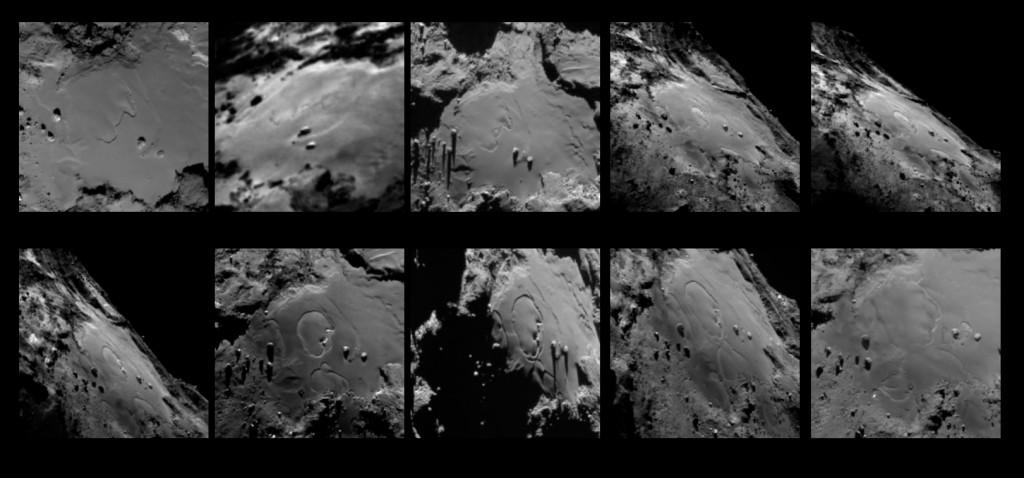
Sequence of ten images showing changes in the Imhotep region on Comet 67P/C-G. The images were taken with the OSIRIS narrow-angle camera on Rosetta between 24 May and 11 July 2015. The individual images are also available separately. Credits: ESA/Rosetta/MPS for OSIRIS Team MPS/UPD/LAM/IAA/SSO/INTA/UPM/DASP/IDA
“We had been closely monitoring the Imhotep region since August 2014, and as late as May 2015, we had detected no changes down to scales of a tenth of a metre,” comments Olivier Groussin, an astronomer at the Laboratoire d’Astrophysique de Marseille, France, OSIRIS Co-Investigator and lead author of the study.
“Then one morning we noticed that something new had happened: the surface of Imhotep had started to change dramatically. The changes kept going on for quite a while.”
First evidence for a new, roughly round feature in Imhotep was seen in an image taken with Rosetta’s OSIRIS narrow-angle camera on 3 June. Subsequent images later in June showed this feature growing in size, and being joined by a second round feature. By 2 July, they had reached diameters of roughly 220 m and 140 m, respectively, and another new feature began to appear.
By the time of the last image used in this study, taken on 11 July, these three features had merged into one larger region and yet another two features had appeared.
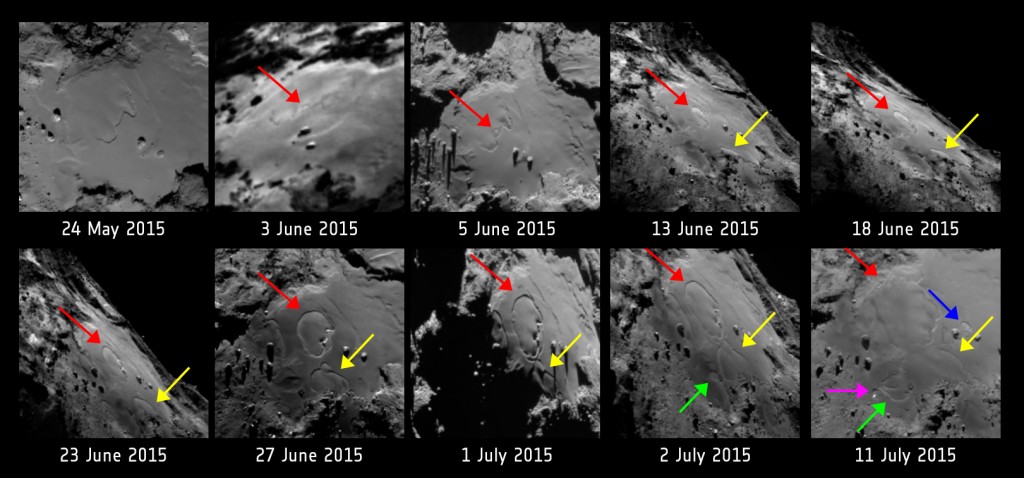
Same sequence as above, with indication of dates and location of the morphological changes. Credits: ESA/Rosetta/MPS for OSIRIS Team MPS/UPD/LAM/IAA/SSO/INTA/UPM/DASP/IDA
“These spectacular changes are proceeding extremely rapidly, with the rims of the features expanding by a few tens of centimetres per hour. This highlights the complexity of the physical processes involved,” adds Olivier.
The sublimation of volatile species is clearly an important factor, as colour images of this region reveal the signature of exposed ice on some of the rims of the newly-formed surface features. The rapid rate of expansion is unexpected, however: models of sunlight-driven sublimation would predict erosion rates of just a few centimetres per hour, and thus the scientists believe that additional mechanisms are required to explain the observations.
A simple possibility is that the surface material is very weak, allowing for more rapid erosion, but it is also possible that the crystallisation of amorphous ice or the destabilisation of so-called ‘clathrates’ (a lattice of one kind of molecule containing other molecules) could liberate energy and thus drive the expansion of the features at faster speeds.
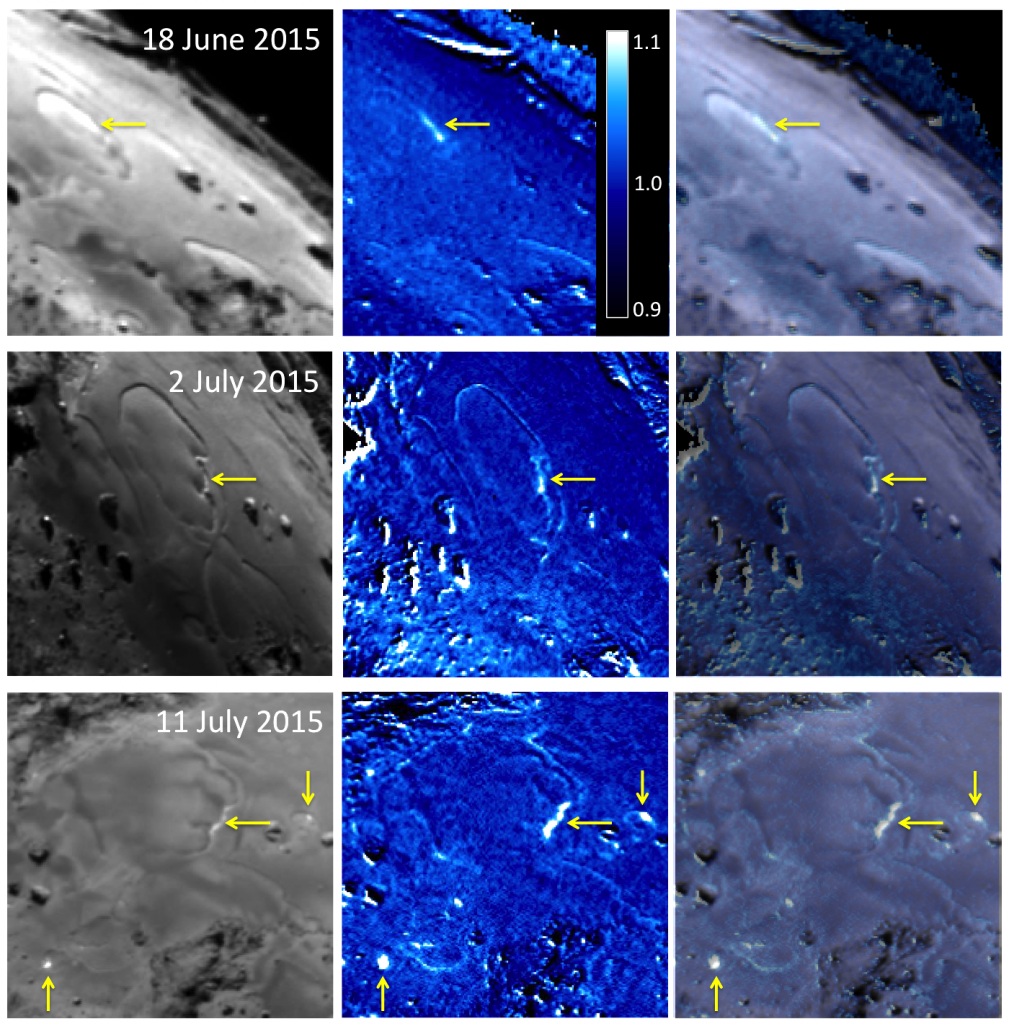
Colour images of the Imhotep region on Comet 67P/C-G, taken with the OSIRIS narrow-angle camera on Rosetta on 18 June (upper row), 2 July (middle row) and 11 July 2015 (lower row). The first column shows images taken in the orange filter (649 nanometres); the second column shows the ratio between images taken with the blue filter (481 nanometres) and the orange filter for the 18 June and 2 July images, and the ratio between images taken with the blue and the red (701 nanometres) filters for the 11 July image; the third column shows a composite obtained by combining the images in the previous two columns. The yellow arrows indicate some of the new features that were detected on Imhotep. These colour images show that some patches on the surface of the comet reflect orange/red light less effectively and blue light more effectively than their surroundings. They appear as white in the central column, where the colour ratio is shown. This indicates the presence of frozen water ice at or just below the surface of these patches. Credits: ESA/Rosetta/MPS for OSIRIS Team MPS/UPD/LAM/IAA/SSO/INTA/UPM/DASP/IDA
The erosion could be accompanied by increased rates of gas outflow, including H2O, CO2, or CO. The scientists also searched in OSIRIS images for evidence of increased dust rising from Imhotep as the surface morphology evolved, but did not find any.
While it is unlikely that many small (micron-sized) dust particles were released as the features formed and expanded, it is possible that the same amount of mass was released in a smaller number of larger (millimetre-sized) particles, which would produce less reflected light and thus be harder to detect with OSIRIS.
In addition, a significant fraction of the dust released may have immediately fallen back to the surface, accumulating at the base of the expanding rims.
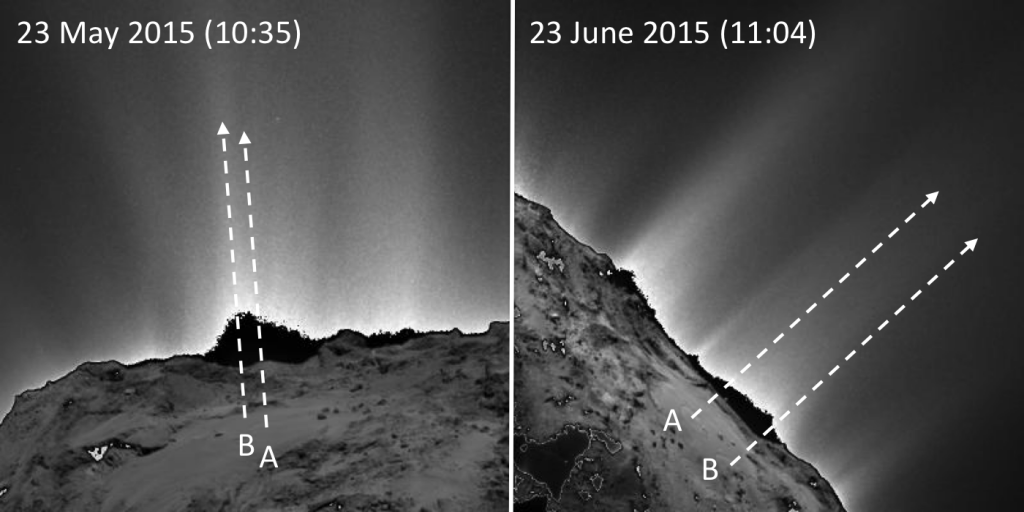
Activity seen above the Imhotep region with the OSIRIS narrow-angle camera on Rosetta on 23 May 2015 (left), before significant morphological changes were seen in this region, and on 23 June 2015 (right), after the changes had begun to appear. (Times are in UT.) The positions of the first two new features that were seen in Imhotep are marked with A and B. The white arrows indicate the direction along which an increase of activity would have been seen in the case of jets lifting from the newly arisen features. Credits: ESA/Rosetta/MPS for OSIRIS Team MPS/UPD/LAM/IAA/SSO/INTA/UPM/DASP/IDA
Although the scientists were initially surprised to see such significant changes taking place on smooth terrains such as those seen in Imhotep, the location of this region close to the comet’s equator guarantees that it receives large amounts of sunlight.
“We are looking forward to combining our OSIRIS observations with data from other instruments on Rosetta, to piece together the origin of these curious features,” concludes Olivier.
—
“Temporal morphological changes in the Imhotep region of comet 67P/Churyumov-Gerasimenko” by O. Groussin et al. is to be published in Astronomy & Astrophysics.
The individual images are provided below:
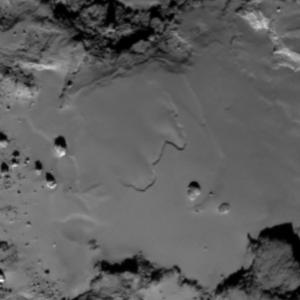
The Imhotep region on Comet 67P/C-G on 24 May 2015. Credits: ESA/Rosetta/MPS for OSIRIS Team MPS/UPD/LAM/IAA/SSO/INTA/UPM/DASP/IDA
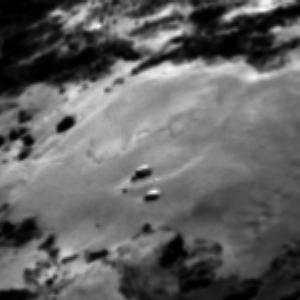
The Imhotep region on Comet 67P/C-G on 3 June 2015. Credits: ESA/Rosetta/MPS for OSIRIS Team MPS/UPD/LAM/IAA/SSO/INTA/UPM/DASP/IDA
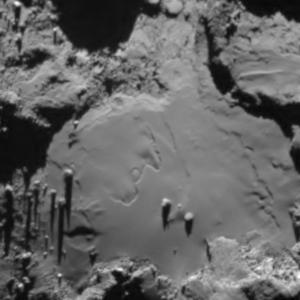
The Imhotep region on Comet 67P/C-G on 5 June 2015. Credits: ESA/Rosetta/MPS for OSIRIS Team MPS/UPD/LAM/IAA/SSO/INTA/UPM/DASP/IDA
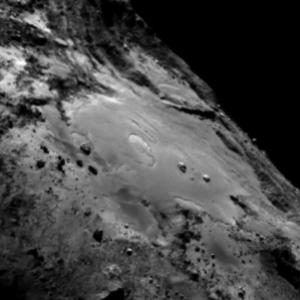
The Imhotep region on Comet 67P/C-G on 13 June 2015. Credits: ESA/Rosetta/MPS for OSIRIS Team MPS/UPD/LAM/IAA/SSO/INTA/UPM/DASP/IDA
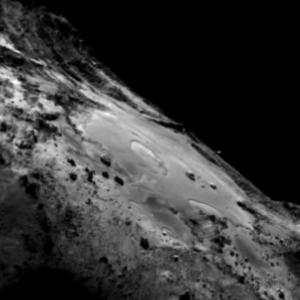
The Imhotep region on Comet 67P/C-G on 18 June 2015. Credits: ESA/Rosetta/MPS for OSIRIS Team MPS/UPD/LAM/IAA/SSO/INTA/UPM/DASP/IDA
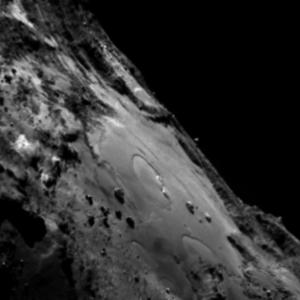
The Imhotep region on Comet 67P/C-G on 23 June 2015. Credits: ESA/Rosetta/MPS for OSIRIS Team MPS/UPD/LAM/IAA/SSO/INTA/UPM/DASP/IDA
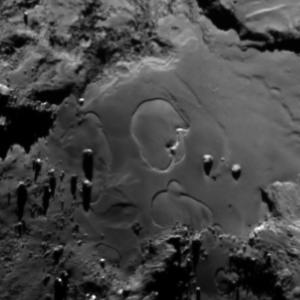
The Imhotep region on Comet 67P/C-G on 27 June 2015. Credits: ESA/Rosetta/MPS for OSIRIS Team MPS/UPD/LAM/IAA/SSO/INTA/UPM/DASP/IDA
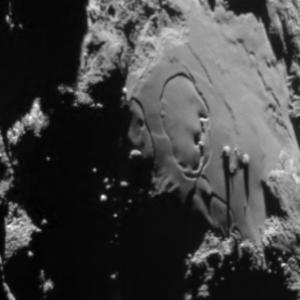
The Imhotep region on Comet 67P/C-G on 1 July 2015. Credits: ESA/Rosetta/MPS for OSIRIS Team MPS/UPD/LAM/IAA/SSO/INTA/UPM/DASP/IDA

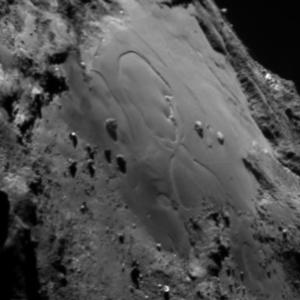
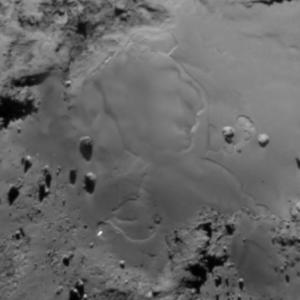








Discussion: 54 comments
This is very strange.
A large flat area which showed reasonable amount of outgassing and outbursts through to May 2015 without a single noticeable surface change, then shows a dramatic series of changes with no noticeable change in outgassing or outbursts concurrent with those changes.
To summarise briefly – outgassing without erosion, then erosion without outgassing.
Perhaps the outgassing is not from the surface, but from somewhat below the surface. Once the subsurface is depleted of material, the surface slumps down from the point of least resistance then pulls down adjoining sections in a chain reaction growing into ever bigger circles.
There is clearly material and gas being expelled from the comet, but it is not directly reflecting in surface changes. If it is related to outgassing at all, it is very indirectly related.
Cool idea. It reminds me of this https://www.usgs.gov/newsroom/article.asp?ID=3731#.VfxlzBFViko
Perhaps subsurface material is being “pumped out” and outgassed through other parts of the comet. Perhaps there are previously established paths of least resistance in the comet for outgassing. Or perhaps the surface of the Imhotep region is less permeable/harder compared to other regions, forcing subsurface material to outgas somewhere else? Cool!
Hi Jen,
That is precisely what I was getting at as far as the slumping goes. As to the mechanism, all we can say is that it appears complicated. Not a simple surface erosion proportional to insolation.
Marco
Your explanation of the weakest point and pulling down adjacent areas is consistent with mass wastage along the first fracture plane below the surface. This is in turn consistent with the outgassing seen from the adjacent low area as described in the sudden nighttime jet which was pinned down to the low area by Mattias Malmer (my interpretation of his pictures). This jet occurred at other times too and I suggested at the time that it was coming from the same lowest-point fracture plane as the hypothesised slurry had. So yes, all the relevant outgassing and consequent mass wastage was slow, steady and long in advance of the sudden collapse which you characterise very well.
Excellent stuff. The sort of observations which justify the raison d’etre of this mission.
One can only hope that contemporaneous measurements were made regarding the temperature of the region, and of the sublimating species above it.
Have seen Mr. Groussin’s name on a number of comet papers over the years; he must be in cometologist heaven at the moment!
Two questions. How does white indicate ice as described in the caption under the filtered pictures?
Also, in relation to the article quote below…
““These spectacular changes are proceeding extremely rapidly, with the rims of the features expanding by a few tens of centimetres per hour. This highlights the complexity of the physical processes involved,” adds Olivier.
The sublimation of volatile species is clearly an important factor, as colour images of this region reveal the signature of exposed ice on some of the rims of the newly-formed surface features. The rapid rate of expansion is unexpected, however: models of sunlight-driven sublimation would predict erosion rates of just a few centimetres per hour, and thus the scientists believe that additional mechanisms are required to explain the observations.”
…how high (deep) are the ridges? Frustrating that this is not mentioned since it makes a huge difference in the significance of the erosion. If the ridges are a few centimeters high, the rapid expansion rate is easier to wrap one’s head around. But based on their shadows, they seem much higher than this, and if several meters high, that is a whole lot of material being shifted about or removed. If it’s been possible to monitor and detect changes “down to scales of a tenth of a metre,” surely it’s known how high the ridges are.
Based on the July 2 picture, with the diameter of the larger feature being “roughly 220 m”, the clearly resolved far rim can not, proportionally, be less than 5 metres high. That indeed represents a lot of missing matter – roughly 45,000 cubic metres, in fact.
Extraordinary too how perfectly flat and smooth the newly lowered surface is – even flatter and smoother, in fact, than the original Imhotep surface was before being resurfaced in this way… And why are these new features all initially circular anyway, like many other much larger, more rugged features on the surface of the comet are? Given these inexplicably regular characteristics (flatness, smoothness and circularity), the erosion process at work here looks to me much more like a low-intensity EDM (electrical discharge machining) process, which produces precisely these characteristics, than any necessarily random and chaotic process such as sublimation of the hypothetical ice accompanied by collapse of hypothetical subsurface cavities. As for jets of sublimated gases entraining dust, they are apparently ruled out by the failure to observe any. So how can these surface changes be due in any way to the fact that “the location of this region close to the comet’s equator guarantees that it receives large amounts of sunlight”? For as long as the mission scientists fail to recognize any other energy source than gentle solar heating for the dynamic erosion processes taking place “before Rosetta’s eyes”, they will always find such events and features “curious”, as Olivier Groussin mildly puts it.
I use EDM on a regular basis, and bought a CNC EDM machine for our workshop.
It is conducted *under paraffin*, with a distance from the tool to the necessarily *conducting* work piece of a fraction of a millimetre. You cannot EDM insulators (I wish you could.) The discharge is pulsed, and produces pits typically tens of microns across. The shape removed from the workpiece is essentially a close copy of the shape of the tool, commonly made from copper.
If you want to produce a flat surface using EDM, you need a *conducting* surface to work on and a flat conducting tool very close to it. And on an area that size, you will need one heck of a pulsed power supply.
So I struggle to see any similarity whatever between ‘EDM’ in the normally meaning of that abbreviation and processes on 67P.
Harvey, I seem to remember that you were one of the first, many months ago, to reproach me (and others) with believing that Earth-linked comparisons and similarities could be applicable to such an utterly different body as 67P. I’m therefore a little surprised to now find you basing your arguments on exactly the same sort of logical procedure. It is my turn now to suggest that Nature itself knows far more about how electricity can machine surfaces than we ever will and that it does more with electricity, at unimaginably vaster scales, than we can truly comprehend. We have literally only just started to scratch the surface. I have all due respect for your laboratory experience, but I do not accept it as a model for what electricity is doing to the surface of 67P. It can hardly be the gentle diurnal workings of the “water-cycle” as they are described on another thread which can account for either the erosion process we see at work here or the spectacular jets, outbursts and explosive flashes Rosetta has imaged recently. There is a totally different, vastly more powerful force at work which mission scientists are understandably struggling to understand.
You are absolutely right THOMAS. It is obvious that these features did not form by warming of the surface and loss of material through sublimation. Another process was at work and all indications are that it was an arc discharge process. Objectivity would require this to be investigated.
In fact when the images shown were captured it looks as though the discharge erosion process was still going on, judging by the white areas dotted about. These are likely to be localised arc discharges in progress. EDM effects are still likely elsewhere on the erosion front, in dark mode, but the white arc points represent the highest current and the greatest activity. This supposition could easily be confirmed or refuted, as we have discussed before, by measuring the temperature of the white points. If they are arc discharges the indication would be several thousand degrees Celsius. Perhaps they do not have a pyrometer on board that is sensitive to temperatures at that level.
@ Originaljohn
After further study of Thomas Appéré’ s extremely enlightening animation (https://www.flickr.com/photos/105035663@N07/21348320399/sizes/o/), it becomes clear that the brighter areas which are presented in the write-up as “exposed ice on some of the rims of the newly-formed surface features” can hardly be “exposed ice”, given their precise location: they are in fact located squarely on the edge of the OLD escarpment which has been clearly visible as a long, dark, squiggly line on the Imhotep plain since the first images were released of our old friend, the big boulder Cheops, in a blog-post over a year ago… (https://blogs.esa.int/rosetta/2014/10/09/boulder-close-up/). If you bend your head 90° over to the right, the squiggly line actually looks like the headless shoulders and arms of a giant, with his left, raised, arm pointing straight at Cheops.
In the June 5 image, the giant has suddenly acquired a head in the shape of a first circular feature and in the June 27 picture the bright white patches are clearly located on the giant’s shoulders, i.e. on the rim of the original “old” escarpment… There is thus no way that this can be newly exposed ice: these white patches are indeed localized arc-mode discharges to the higher points of the discharge zone, while the rest of the zone is being subjected to considerably lower-intensity discharges which are resurfacing the whole area.
Originaljohn, they measure almost the whole electromagnetic spectrum. I’m sure a measurement of a temperature of several 1000 degrees would go the shortest way to the press.
So I’m sorry, no arc discharge.
“Extraordinary too how perfectly flat and smooth the newly lowered surface is – even flatter and smoother, in fact, than the original Imhotep surface was before being resurfaced in this way… ”
Agree, THOMAS 🙂
Could also bet in an general lower gravitational slope 🙂
The answer is in the paper; 5m +\- 2m. And nobody is saying the whole of the depth of the depressions has been lost from the comet. Dust transportation is also mentioned in the paper .
“The lack of enhanced dust activity in the coma during the
period of changes suggests that the dust deposit is dominated by millimeter-sized or larger particles and not by microscopic ones. Grains up to the decimeter scale are observed in the smooth terrains of Imhotep (Auger et al. 2015). During the eroding process, a fraction of dust particles falls and accumulates at the foot of the expanding features, or particles are transported slightly farther away, toward the center of the newly formed roundish features. This material transport might explain the bumpy shape
of feature A (1 July, Fig 1), with more material in the center
than on the edges. The fraction of particles that escape the nucleus is unkown and cannot be determined by OSIRIS alone. We also add that if the nucleus is porous, a significant fraction of dust particles may sink into it during this process. Finally, it is worth mentioning that the surface material in the evolving regions looks photometrically essentially the same before and after the changes (Fig. 1).”
I’m not sure why links to papers are provided, if people aren’t going to bother reading them, but then come on here berating scientists for not providing the data!
Hi SS,
Having read the paper, they mention 5 metres as the general height of the ridges, I believe.
Wow, a 5 meter high ridge getting eaten away at a rate of at least 20 cm an hour. This is rather stunning. And as you say Marco, outgassing without erosion, then erosion without outgassing. Also wonder how the edges keep their vertical ridgy shape during all that activity. The article indicates that sublimation alone can’t account for this, and the scientists are conceding that there must be other mechanisms at work. As more and more is being learned about P67, trying to make sublimation alone be the explanation at every turn is obviously over simplistic. There are things here that defy simple explanations. Perhaps it’s time to expand paradigms a bit.
Seems there are two options. Either there are unexpected and unexplained and unusual properties to the comet itself, or there are unexpected and unexplained and unusual forces acting upon the comet, or perhaps a combination of course. I guess those in the sublimation camp would align more with the first, EU with the second. Maybe both are to some extent right.
-Strongly interesting !
But what happened AFTER 11 July ?
Please give some information about the evolution of the fenomena around the perihelion. Obviously there is a STRONG curiosity on the subject !
Thanks for almost some qualitative information.
-What about the possibility that Imhotep should be the sourse of one of the big jets observed from Earth during the last perihelium ?
Thanks a lot for a reply !
Is the big flash on 22 August from this region?
I think not, Kamal. I predict that the August 22 event is likely to have produced considerably more extensive alterations to the area concerned by the “flash” than the very gradual erosion observed here.
Thomas (what should i say, electéré ?)
We are all busy putting forth our views, I was just looking for some factual information.
Kamal
Sure, Kamal, so am I; and I sincerely hope we one day get the before-and-after pictures from the area of the flash. – the difference should be spectacular.
So easy to read. Like a royal diamond the quality of this document. Congratulations to All Teams.
I created an animation using nadir pictures of Imhotep region provided in this article. It highlights these spectacular surface changes:
https://www.flickr.com/photos/105035663@N07/21348320399/sizes/o/
Many thanks for this extremely enlightening animation, which helps to visualize how the circular features progress over the smooth area of Imhotep, severely eroding the pre-existing, sharply-defined, crooked-lined, escarpment by several tens of metres in the process.
Thomas: From your animation, here is a possible scenario. Some ices get exposed. They sublimate leaving a kind of sinkhole (the 27 June picture shows what looks like one at site A and one can find them for other sites). This happens between 23 May and 23 June and no jet increase is seen on these two dates. For some reason (a combination of gravitation and pressure? subsurface fluidization?) this makes the dust from the surrounding region move towards the sinkhole leading to the well-defined 5-metre cliff feature, which moves outward as more and more dust comes inwards. Over time the dust covers the sinkhole.
Preliminary evidence of un-correlation between an apparent massive sublimation event and visual ‘jetting’.
https://blogs.esa.int/rosetta/files/2015/09/Imhotep_dust_activity.png
Smoothness of Imhotep is a say due to distance and presumed dynamics of the basin. ‘Boots on the ground’ should show a view of a ‘rocks and gravel’ dessert [big gravel].
When erosion re-ignited also a ‘rain’ of loose, sandy material started to ‘infiltrate’ down to a subduing, clogging layer.
This speculative infiltrated, warm sand, acting in conjunction with the pressure of the particulate column, causing the collapse of the material, at that particular dept.
That ‘collapsing’ line is a metamorphic material, created by 67P, herself 🙂
A slow motion avalanche running away from the sun, speculatively inducted by ‘crushing’ of the material, at 5-10m depth?
That ‘crushed’ material is causing the ‘raised’ borders. Maybe by subduing.
As we used to say a year ago: ‘Something is flowing under there” Now we know it flows VERY slow to be a liquid. Lakritz?
Lakritz recipe seems to include crushed ices 🙂
During Rosetta’s close flyby in February we had some discussion about fluidization creating layers of the kind we are now seeing appear. Is this a viable explanation?
Hi Kamal. Fluidization is equilibrium phenomena. Think is transient and localized.
Great paper. This ties in with my initial speculation om on the mechanisms behind the deflationary and erosional processes that we were seeing on the North Polar Plains, which “Lit Up” first.
It would be greater to see what changes have occurred using the early and late OSIRIS imagery. Is there any idea if and when Herr Seirks, et al, will allow public access to our data?
–Bill
STILL HAVING problems with the captcha verification.
Sorry Bill. Too High Definition as to show those… ‘things’ weaving at us 😉
Just guessing, scientific endeavors shouldn’t include any military restricted tech.
Couldn’t the changing features on the Imhotep region be caused by subsurface melting of a material that is essentially a “mud” of water ice mixed with dust? Melted areas would expand in a roughly circular shape by melting the area around them, and since the comet is porous the melted mud would drain slowly through internal cracks toward the center of the comet, causing the melted circles to be lower than the surrounding area. The entire Imhotep region could be affected by this process happening in different places each time the comet nears perigee and that would explain why the area is so flat.
Paul, the temperatures and pressures on 67P are not compatible with liquid water. Water would go straight from ice to vapour, that is sublime.
Others here have postulated the presence of liquid hydrocarbons which could be compatible, but none have been directly observed and I personally think them rather unlikely but not technically impossible.
But also remember that liquids on 67P would behave nothing like they do on earth. Gravity is so weak they will not ‘drain’, surface tension forces (eg capillary effects etc) become dominant.
67P is a very strange place where you have to discard earthbound experience!
Harvey: Temperature in June as reported by Philae is above zero. Agree that there may be other difficulties with the explanation.
Temperature *and pressure*; it might be above zero, but it would boil away like crazy.
Hi Harvey,
It would not boil away like crazy if it was sealed in a way that is required for the explosive events observed. That is while a breach that would cause said explosive event is avoided. Ie partially sealed to at least 6millibar and at least zero degrees centigrade.
🙂
The pressure is likely too low to allow water to stay liquid.
But a mix of sublimating ices and dust might behave similar to a liquid in the low gravity environment.
Hi Paul,
To play devils advocate here, liquid water requires only 6 millibar of pressure and temperatures of greater than 0 degrees Celsius. 6 Millibar is less than one percent of the Earths atmospheric pressure and can be held back by a variety of gummy substances but necessarily underneath the surface, as any even slight exposure to the surface via even small pores will instantly release such pressure. Explosive outburst events betrays a sudden release of such pressure into the vacuum. Since we cannot measure temperature and pressure below the surface far, we cannot completely rule out any quantity of liquid water until we do measure those parameters.
I, for one, believe there is various indirect circumstantial evidence for liquids including liquid water, and I have theories as to how enough thermal energy gets below a sealed surface into a porous comet for liquid water to exist and persist, but parsimony seems to win out over complexity when nothing is known about the interior.
Hi Marco. Also believing in brines. And expressing favor on sealed chambers, cells and layers since early on. But in an open talk and listen procedure, orders of magnitude and precedences are being adjusted.
Declaring a slow and progressive change of taste over the flow of ideas, true to what honestly believe to see. Did not believe on core electro-dynamics, and very slowly being convinced.
Not minimizing your arguments. Preliminary papers [and infinite gratitude to all the Teams about providing us with this, additional effort], most of tide changes in perspective still to come. Still eagerly awaiting for any data on salts surface distribution.
Looking at 67P reality and seeing immense complexity, as you say. But models have to be constructed anyway. Needed to go forward, to advance discussion.
Ideas have a life of their own.
“…a “mud” of water ice mixed with dust?
As long as you are thinking of crushed water ice, a mostly ‘dry’ mud 🙂
Claudia.
In the 23. may, 23 June pair, we see the ‘Jets’ at the ‘top’ and the terrain in the foreground. But between them is an irregular pitch black band of varying width, oddly with a few detached black pixels in the 23 May picture especially.
I do have my own tentative explanation of that black band, related to sun angle and ‘horizons’, but it has some problems.
Can you explain it for us?
Hi Harvey,
Just checked with the author and he says:
“The “artefacts” results from the fact that I combined two images, one with a short exposure time to show the nucleus, and one with a long exposure time to show the coma. I applied a mask to the nucleus picture, which create these artefacts.”
Best wishes,
Emily
Emily – many thanks, as it’s an image processing artefact it has no relevance in the context I was thinking of.
Many thanks for enquiring – and sorry I called you Claudia!
Have electrochemical effects been considered by this team, as an alternate explanation?
No doubt, Nathan. Commented as ion-erosion. But very low pressure at 5-10m. If liquid water, only a few molecular layers and very transient [wonder if enough for liquid electro-chemistry]. Just speculation here.
‘Pits’ are different phenomena. Kind of related to very focused heat sources.